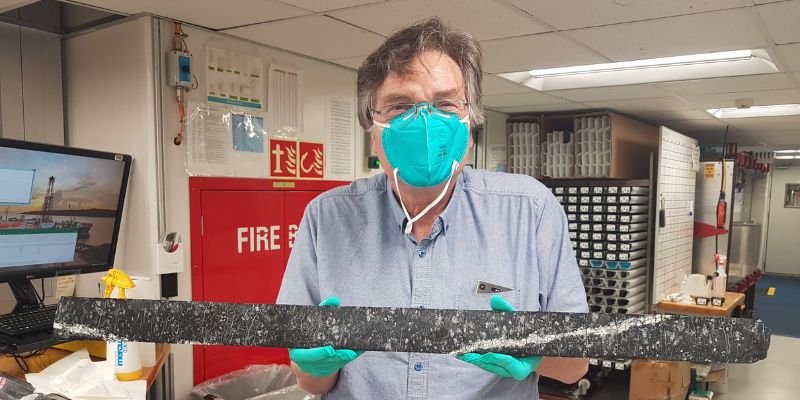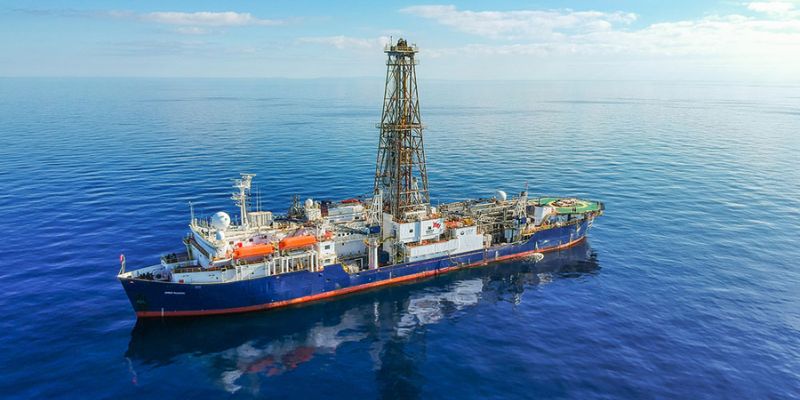
Scientists from the University of Leeds have helped to recover the first long section of rocks that originated in the Earth’s mantle, the layer below the crust and the planet’s largest component.
The team believes the rocks will help unravel the mantle’s role in the origins of life on Earth, the volcanic activity generated when it melts, and how it drives the global cycles of important elements such as carbon and hydrogen.
The nearly continuous 1,268 metres of mantle rock was recovered from a “tectonic window,” a section of the seabed where rocks from the mantle were exposed along the Mid-Atlantic Ridge, during Expedition 399 “Building Blocks of Life, Atlantis Massif” of the ocean drilling vessel JOIDES Resolution in Spring 2023.
All data from the expedition will be fully available, an exemplar of how international science should be conducted.
Dr Andrew McCaig, an Associate Professor in Leeds’ School of Earth and Environment , led the funding proposal for the expedition and was the co-chief scientist on board. He said: “Everyone in the international team from seven countries involved in Expedition 399, starting with the first proposal in 2018, can be proud of the achievements documented in this paper.
“Our new deep hole will be a type section for decades to come in disciplines as diverse as melting processes in the mantle, chemical exchange between rocks and the ocean, organic geochemistry and microbiology.
“All data from the expedition will be fully available, an exemplar of how international science should be conducted.”
With attempts dating back to the early 1960s, the recovery was a record-breaking achievement led by the International Ocean Discovery Program, an international marine research consortium of more than 20 countries that retrieves cores – cylindrical samples of sediment and rock – from the ocean floor to study Earth’s history.
Since then, the expedition team has been compiling an inventory of the recovered mantle rocks to understand their composition, structure and context.

Picture shows the ocean drilling vessel JOIDES Resolution
Their findings, presented in the journal Science, reveal a more extensive history of melting in the recovered rocks than expected.
Lead author Professor Johan Lissenberg from Cardiff University’s School of Earth and Environmental Sciences, said: “When we recovered the rocks last year, it was a major achievement in the history of the Earth sciences, but, more than that, its value is in what the cores of mantle rocks could tell us about the makeup and evolution of our planet.
“Our study begins to look at the composition of the mantle by documenting the mineralogy of the recovered rocks, as well as their chemical makeup. Our results differ from what we expected. There is a lot less of the mineral pyroxene in the rocks, and the rocks have got very high concentrations of magnesium, both of which results from much higher amounts of melting than what we would have predicted.”
This melting occurred as the mantle rose from the deeper parts of the Earth towards the surface. Results from further analysis of this process could have major implications for the understanding of how magma is formed and leads to volcanism, the researchers claim.
They found channels via which melt was transported through the mantle and were are able to track the fate of magma after it is formed and travels upwards to the Earth’s surface.
Fuelling life
The study also provides initial results on how olivine, an abundant mineral in mantle rocks, reacts with seawater, leading to a series of chemical reactions that produce hydrogen and other molecules that can fuel life.
Scientists believe this might have been one of the underpinning processes in the origins of life on Earth.
Dr Ivan Savov, a lecturer in geochemistry and volcanology in Leeds’ School of Earth and Environment, added: “It was a privilege to be part of this unprecedented discovery with its tantalizing and quite unique initial results,” he said.
“We were lucky enough to see a glimpse of what the deep portions of the oceanic plates look like. Never before this has been accomplished in situ within an oceanic environment with all the important accompanying measurements.”
The paper, ‘A long section of serpentinized depleted mantle peridotite,’ is published in Science.
Further information
Photo of Dr Andrew McCaig by Professor Johan Lissenberg.
Photo of ocean drilling vessel JOIDES Resolution by Thomas Ronge
For media enquiries, please contact Kersti Mitchell via k.mitchell@leeds.ac.uk